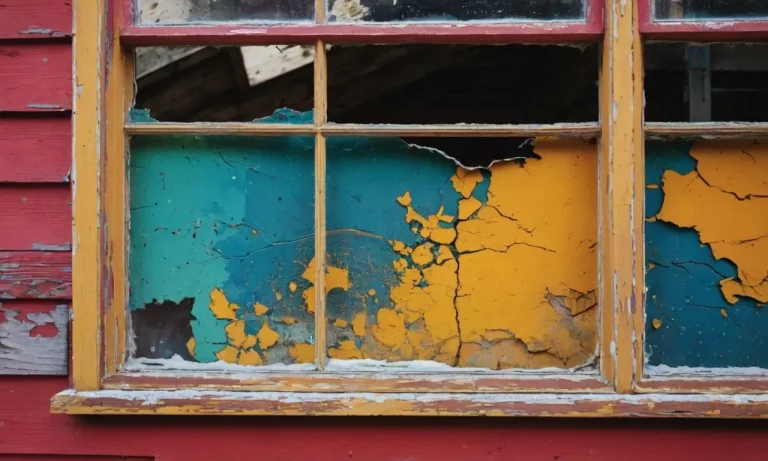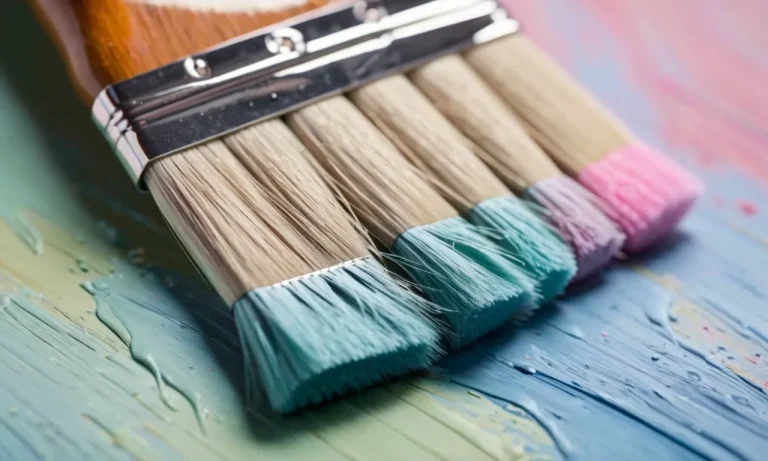How To Remove Paint Transfer From Your Car With Wd-40
Dealing with paint transfer or overspray on your car can be annoying. Those little specks of paint stuck to your car’s exterior are not only unsightly, but can also be difficult to remove if you don’t act quickly.
If you’re short on time, here’s a quick answer to your question: WD-40 is an effective and convenient way to remove small areas of paint transfer from your car’s paintwork. Simply spray it directly onto the affected area, let it sit for 5-10 minutes, then wipe away with a clean microfiber cloth.
In this comprehensive guide, we’ll go over everything you need to know about using WD-40 to get rid of paint transfer on your car. We’ll discuss how it works, tips for effective use, step-by-step instructions, alternatives, and answer some frequently asked questions.
What is Paint Transfer and What Causes It?
Paint transfer refers to the situation where paint from one object gets transferred onto another surface. In the context of cars, it commonly occurs when a vehicle comes into contact with another painted surface, such as another car or a wall.
This results in unsightly marks or streaks of paint on the car’s surface, which can be frustrating for car owners.
Definition of paint transfer
Paint transfer is the process by which paint particles from one surface adhere to and transfer onto another surface upon contact. It can happen due to friction, impact, or rubbing against a painted object. The transferred paint usually leaves behind visible marks or smudges on the affected surface.
Common causes of paint transfer
There are several common causes of paint transfer on cars:
- Collisions or accidents: When two vehicles collide, the impact can cause paint transfer from one car to another. This can happen during minor fender benders or more severe accidents.
- Scrapes and scratches: If a car accidentally brushes against a painted surface, such as a wall or another vehicle, it can result in paint transfer. This often occurs in tight parking spaces or narrow driveways.
- Door dings: When another car’s door accidentally hits the side of a parked vehicle, it can cause paint transfer. This is a common occurrence in crowded parking lots.
- Rubbing against objects: If a car rubs against objects such as poles, fences, or tree branches, it can lead to paint transfer. This can happen while driving or when parked near such objects.
Key takeaways
Paint transfer is the process by which paint particles from one surface adhere to and transfer onto another surface upon contact. It commonly occurs due to collisions, scrapes, scratches, door dings, and rubbing against objects.
These incidents can leave unsightly marks on a car’s surface, requiring appropriate cleaning and restoration techniques to remove the paint transfer effectively.
Can WD-40 Remove Paint Transfer from Cars?
If you have ever experienced the frustration of finding unsightly paint transfer on your car, you may have wondered if WD-40 can come to the rescue. WD-40 is a versatile product known for its ability to lubricate, clean, and protect various surfaces.
But can it effectively remove paint transfer from cars? Let’s take a closer look.
How WD-40 works on paint transfer
WD-40 contains a mixture of solvents and lubricants, which work together to break down and dissolve various substances. When applied to paint transfer, WD-40 can help to loosen the foreign paint particles from the surface of your car.
Its lubricating properties also make it easier to gently wipe away the transferred paint without causing further damage.
Effectiveness of WD-40 for removing paint
WD-40 can be an effective solution for removing paint transfer from cars, especially when the transfer is fresh. It is important to note that the success of using WD-40 depends on the severity and age of the paint transfer, as well as the type of paint used on your car.
In some cases, multiple applications may be required to completely remove the transfer.
According to wd40.com, WD-40 can be used to remove paint transfer, but it is recommended to test it on a small, inconspicuous area of your car first to ensure compatibility with the paint finish. It is also advisable to follow up with a thorough car wash and wax to protect and restore the shine of your car’s paint.
Advantages of using WD-40
Using WD-40 to remove paint transfer from your car offers several advantages. Firstly, it is a cost-effective solution that can save you money compared to professional car detailing services. Secondly, WD-40 is readily available and can be found in most homes or easily purchased from stores.
Lastly, it is a convenient option that allows you to tackle the problem at your own convenience, without having to schedule an appointment or wait for a professional service.
Potential risks and precautions
While WD-40 can be effective for removing paint transfer, it is essential to exercise caution to avoid any unintended damage to your car’s surface. Before applying WD-40, ensure that the area is clean and free of dirt or debris.
Additionally, use a soft cloth or microfiber towel to gently wipe away the transferred paint. Avoid using abrasive materials or aggressive scrubbing, as this could potentially scratch or damage the paint finish.
Step-by-Step: Using WD-40 to Remove Paint Transfer
What you’ll need
Before starting the process of removing paint transfer from your car using WD-40, make sure you have the following items:
- A can of WD-40
- Clean microfiber cloths
- Gentle car wash soap
- Water
- Protective gloves
Instructions
Follow these steps to effectively remove paint transfer from your car:
- Start by washing the affected area with gentle car wash soap and water. This will help remove any dirt or debris on the surface.
- Dry the area thoroughly with a clean microfiber cloth.
- Shake the can of WD-40 well before using it. Spray a small amount directly onto the paint transfer.
- Gently rub the affected area with a clean microfiber cloth. Use light pressure and circular motions to lift the paint transfer.
- Continue rubbing until the paint transfer is completely removed. You may need to repeat this process multiple times for stubborn paint transfer.
- Once the paint transfer is removed, wash the area again with car wash soap and water to remove any residue from the WD-40.
- Dry the area using a clean microfiber cloth.
Tips for best results
To achieve the best results when using WD-40 to remove paint transfer from your car, consider the following tips:
- Test the WD-40 on a small, inconspicuous area of your car first to ensure it does not cause any damage or discoloration.
- Use a gentle touch when rubbing the affected area to avoid scratching the paint.
- If the paint transfer is particularly stubborn, you can use a plastic scraper or a clay bar along with the WD-40 to help remove it.
- Work in small sections and be patient – removing paint transfer can take time and effort.
Aftercare and checking for damage
After removing the paint transfer, it’s important to assess the condition of your car’s paint. Inspect the area closely for any signs of damage or discoloration. If you notice any issues, it may be necessary to seek professional help for repairs.
Remember, always follow the manufacturer’s instructions when using WD-40 and take necessary precautions to protect yourself and your car during the process.
Alternative Methods for Removing Paint Transfer
If you’ve accidentally found yourself with paint transfer on your car, don’t worry! There are several alternative methods you can try to effectively remove it. Here are some popular options:
Clay bar
A clay bar is a great tool for removing paint transfer. It works by gently lifting the paint particles off the surface of your car. Simply lubricate the clay bar with a detailing spray and lightly glide it over the affected area.
The clay bar will pick up the paint transfer, leaving your car’s paintwork clean and smooth.
Polish or compound
Polishing or compounding can be used to remove paint transfer as well. These products contain abrasive particles that help to remove the unwanted paint. Apply a small amount of polish or compound to a microfiber cloth and rub it onto the affected area in circular motions.
This method may require a bit more elbow grease, but it can effectively restore your car’s paint.
Isopropyl alcohol
Isopropyl alcohol, also known as rubbing alcohol, is another option for removing paint transfer. It works by breaking down the paint particles, making them easier to remove. Apply a small amount of isopropyl alcohol to a clean cloth and gently rub it onto the affected area.
Be sure to rinse the area thoroughly afterwards to remove any residue.
Acetone
Acetone can be used as a last resort for stubborn paint transfer. However, it should be used with caution as it is a strong solvent that can damage your car’s paint if not used properly. Apply a small amount of acetone to a cloth and gently rub it onto the affected area.
Be sure to rinse the area thoroughly afterwards and apply a wax or sealant to protect the paint.
Bug and tar remover sprays
Bug and tar remover sprays are designed to remove stubborn stains from your car’s exterior, including paint transfer. Simply spray the affected area, let it sit for a few minutes, and then wipe it away with a clean cloth.
These sprays are usually safe to use on most car surfaces, but be sure to read the instructions and test it on a small area first.
Heat gun
A heat gun can be used to remove paint transfer, especially if it is thick or has been on the surface for a long time. Use the heat gun on a low setting and hold it a few inches away from the paint transfer.
Gently heat the area until the paint starts to soften, and then use a clean cloth to wipe it away. Be careful not to overheat the area or damage the paint.
Sandpaper
Sandpaper should be used as a last resort for extreme cases of paint transfer. Start with a high grit sandpaper and gently sand the affected area in a circular motion. Gradually move to a finer grit sandpaper until the paint transfer is removed.
However, be aware that sanding can damage the clear coat and paint, so proceed with caution and consider seeking professional help if needed.
Remember, when using any of these alternative methods, it’s important to test them on a small, inconspicuous area of your car first to ensure they won’t cause any damage. Additionally, always follow the instructions provided by the manufacturer of the product you are using.
FAQs about WD-40 for Paint Transfer
How long should I leave the WD-40 to soak?
When using WD-40 to remove paint transfer from your car, it’s best to let it soak for a few minutes. The amount of time will depend on the severity of the paint transfer and the type of paint on your car.
In most cases, leaving the WD-40 on the affected area for about 5-10 minutes should be sufficient. However, for more stubborn paint transfer, you may need to let it soak for longer or repeat the process.
Will WD-40 damage my car’s paint?
No, WD-40 is generally safe to use on car paint. It is specifically formulated to be gentle on surfaces while still being effective at removing tough stains and debris. However, it’s always a good idea to test a small, inconspicuous area of your car first to ensure that there are no adverse reactions.
Additionally, make sure to follow the instructions on the WD-40 can and use it as directed to minimize any potential risks.
Can I use WD-40 to remove dried/old paint transfer?
Yes, WD-40 can be used to remove dried or old paint transfer from your car. However, keep in mind that it may require more time and effort compared to fresh paint transfer. You may need to let the WD-40 soak for a longer period and use a soft cloth or sponge to gently scrub the affected area.
It’s also important to note that if the paint transfer has been on your car for a long time, it may have caused some damage or discoloration. In such cases, it’s best to consult a professional for advice.
Is WD-40 safe for all car paint types?
WD-40 is generally safe for most car paint types, including clear coats and enamel. However, it’s always a good idea to check your car’s manufacturer guidelines or consult a professional if you have any concerns.
Some specialty or custom paint finishes may require specific care or products, so it’s important to ensure compatibility before using WD-40. Additionally, if your car has any existing paint damage or repairs, it’s best to seek professional assistance to avoid any further issues.
What’s the best technique for applying WD-40?
The best technique for applying WD-40 to remove paint transfer from your car is to spray a moderate amount directly onto the affected area. Allow it to soak for a few minutes to loosen the paint transfer. Then, using a soft cloth or sponge, gently rub the area in a circular motion.
Start with light pressure and gradually increase if needed. Once the paint transfer is removed, wipe away any residue with a clean cloth. Remember to follow up with a thorough wash and wax to protect the paint and restore its shine.
Conclusion
In most cases, WD-40 can safely and effectively remove small areas of fresh paint transfer from your car’s exterior. Just make sure to follow the proper techniques for application and cleaning.
While other methods like clay bars and polishes may work, WD-40 offers a quick, convenient, and affordable way to tackle minor paint transfer damage. Act quickly after noticing paint overspray before it has time to fully cure.
With some patience and elbow grease, you can easily get your car looking clean and speck-free using WD-40. Just test it first and be gentle while wiping to avoid damaging the clearcoat. And consider a professional auto detail if the paint transfer is extensive.







